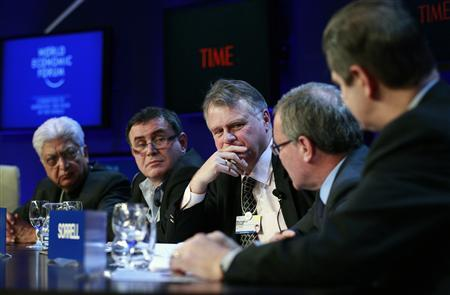Davos Man meets Girl
UPDATE 12:40 pm: Readers point us to an example of a "girl-focused" campaign gone badly awry. The Girl Store markets school supplies in an extremely creepy and objectifying video that asks you to "Buy a girl before someone else does." Sign a petition against this campaign here. --
In the new issue of the e-journal Contestations, Rosalind Eybens asks, What is Happening to Donor Support for Women’s Rights?:
Recent years have seen a marked shift in official development discourse, with less emphasis on a rights-based approach and more on an efficiency approach to gender equality, a tone set by the World Bank’s 2006 action plan – ‘Gender equality is smart economics’….Other equally disturbing trends are emerging, such as DFID’s adoption of the Nike Foundation’s ‘Girl Effect’ theme of ‘stopping poverty before it starts’ by ‘investing in girls’ – an approach that entirely ignores the historically derived structural inequities that are keeping many millions of girls [and boys!] in conditions of poverty.
The yearly gathering of the word’s rich and powerful that took place at Davos last week is an equally good example of this new approach. “Six Global Challenges, One Solution: Women” was the not at all over-promising title of Thursday’s panel on women and society. Recent years’ sessions on women and development have also taken place within the “Girl Effect” rhetorical framework: girls are the “world’s greatest source of untapped potential” and must be seen as “a resource and an asset.” “Investing in adolescent girls” “yields a higher return in improving the local economy than any other type of investment” and is a “cost-effective tool” in “lesser developed countries.”
(Never mind that this year, to compensate for the rich world’s utter failure to achieve gender equality at the highest levels of power, Davos organizers had to make it a requirement that their top 100 corporate members make at least one of their five delegates a women, and 20 of them were unable to do so. They were perhaps outnumbered by “Davos wives” whom, according to one poignant account, the other Davos men snub as non-persons.)
The problem is that the message of the “Girl Effect,” is “profoundly anti-rights,” according to Eyben, in that:
The seeming triumph of the 1990s had been that social justice was seen as a sufficient reason for efforts to be made to secure gender equality. Women’s and girls’ well-being was an end in itself. Today, it is all about calculating the rates of return from investing in a person as if she were a piece of machinery.
Emily Esplen describes the dilemma posed by “the Girl Effect” Effect for women’s rights advocates:
Our cause is being championed but not in the way we intended; it has been sapped of political intent and reduced to a technocratic problem. DFID’s ‘unrelenting focus on results’ … incentivises and intensifies this technocratic, de-political approach to women’s empowerment, and to development more broadly.
Even our own local aspiring feminist weighs in, expanding on a discussion that took place here on the blog a few weeks ago:
The debate over the Nike “Girl Effect” video has unintentionally revealed a deep divide in approaches to development, with the two sides close to mutual incomprehension. The divide is between … the technocratic approach and the rights approach.
…The technocratic approach never really tests the proposition …that technocracy will eventually yield equal rights, despite the technocratic veneration for “evidence.” Nor does the technocratic vision consider how much “we” may violate such rights …of “them” along the way. Even if there were such evidence, it would not address whether the final state of equal rights made it “worth it” to violate rights along the way, and above all - who gets to decide?
Putting rights at the end inevitably enmeshes “us” in a tangle of paradoxes in which it will always be unclear who is benefiting from whom, or who is harming whom. Rights must come first, not last.
--
Related posts: So now we have to save ourselves and the world, too? A critique of “the girl effect” It takes more than a cow, but…girls still count
 From Aid to Equality
From Aid to Equality

